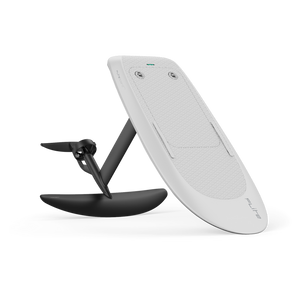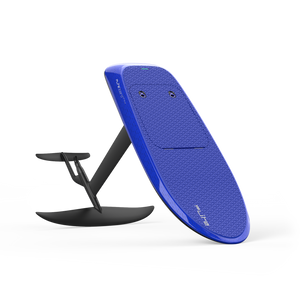How long does an eFoil battery last?
This is one of the most common questions and the answer varies depending on a number of factors, so most estimates offer a ballpark duration of battery life. The most precise tool that exists to measure battery life is the Fliteboard Foil Time Calculator which takes into account real data to educate customers in a visual way on the true impact of wing selection, propulsion, rider weight and battery selection. In general, most eFoil batteries are designed to give riders a solid amount of riding time before needing to be recharged. Let’s explore what influences battery life and what to expect from your eFoil battery.

1. Battery capacity
The battery capacity of an eFoil is typically measured in watt-hours (Wh), which represents how much energy the battery can store. Higher-capacity batteries, which range from around 1,500Wh to over 2,000Wh, can provide more extended ride times. However, it's essential to note that higher capacity often means a heavier battery, which could impact the overall performance and maneuverability of the eFoil. The lightest lithium-ion efoil battery in the world, the Flitecell Nano, is just 13.7lbs / 6.2kg and offers riders a foil time of up to 45 mins.

2. Rider weight
Just as with any electric vehicle, the rider’s weight significantly impacts battery performance. Heavier riders require more energy to stay on the foil, which can reduce the overall run time. For example, a heavier rider might get 60 minutes of ride time, while a lighter rider might enjoy up to 90 minutes on the same battery.

3. Riding style
Aggressive riding or maintaining high speeds will drain your battery faster than cruising at moderate speeds. If you’re constantly pushing your eFoil to its top speeds or doing frequent sharp turns or jumps, you might find your battery depleting quicker than if you were simply gliding along in calm waters. Beginners often deplete the battery quickly as there is a lot of starting and stopping involved in learning and more frequent touchdowns.

4. Wing choice
Wing choice plays a significant role in how long an eFoil battery will last. In general, larger wings provide more lift at lower speeds, allowing riders to foil more efficiently and conserve battery life. Since they require less power to maintain lift, riders can enjoy longer sessions. On the other hand, smaller wings need faster speeds to generate the same lift, demanding more power from the motor and depleting the battery more quickly.

5. Water Conditions
The condition of the water you’re riding in also plays a role in battery life. Rougher water requires more power from the motor to keep you up on foil, which can reduce ride time. Conversely, riding in calm, flat water is much easier on the battery, extending its lifespan.

6. General ride time
Most eFoil batteries offer between 60 and 90 minutes of ride time, under average conditions. However, it’s essential to manage your expectations based on the factors mentioned above. Heavier riders, choppy waters, high speeds, or colder weather can all lead to shorter ride times, while ideal conditions may give you a longer session.

7. Recharging
eFoil batteries typically charge in less than 2 hours, depending on the specific model and charger used. Many riders choose to have a second battery on hand for extended sessions. Swapping out a drained battery for a fresh one allows you to get back on the water quickly without waiting for a full charge.

8. Safety
eFoil battery safety is essential for ensuring both the longevity of the battery and the rider’s protection. Always handle the battery with care, avoiding exposure to water or extreme heat. Make sure to charge the battery using the manufacturer-recommended charger, and avoid overcharging. Inspect the battery regularly for any signs of damage, swelling, or leaks, and store it in a cool, dry place when not in use. Proper maintenance and following safety guidelines will help prevent accidents and keep your eFoil running smoothly for longer.
When buying an eFoil, it’s important to consider key battery safety features to ensure reliability and durability. Here are some crucial safety aspects to look for:
- Drop Tested Batteries: Ensure the battery has undergone drop testing to confirm its resilience against impact, reducing the risk of damage from accidental falls.
- Titanium or Reinforced Construction: High-quality, robust materials like titanium or reinforced casings provide extra protection against physical damage and corrosion, ensuring longer battery life in harsh marine environments.
- Phase-Changing Materials (PCM): These materials help regulate the battery's temperature during use, preventing overheating and thermal runaway.
- High Impedance Cells: Batteries with high-impedance cells are designed to reduce the likelihood of short circuits, providing greater safety and stability under different conditions.
- Sight Glass or Indicators: Some batteries feature a sight glass or similar mechanism to allow easy inspection to determine if there has been any water ingress, helping to quickly detect potential issues.
- Safety Record: Research the manufacturer’s safety record, including customer reviews and any reported incidents, to gauge how reliably the battery performs over time.
- Waterproof Sealing: The battery should have a solid waterproof rating (like IP67 or higher), ensuring it is fully protected from water ingress, which could lead to short circuits or battery failure.
These features can significantly enhance both the performance and safety of your eFoil battery, offering peace of mind while on the water. Fliteboard Flitecells feature all of the above and are tested to standards far higher than the industry requires.
Maximizing battery life
To get the most out of your eFoil battery, here are a few tips:
- Avoid high speeds for extended periods.
- Ride in calmer waters when possible.
- Store your battery in moderate temperatures to preserve its longevity.
- Regularly check the health of your battery and keep it charged within recommended levels to prolong its overall life.
Conclusion
While eFoil battery life can vary based on several factors, most riders can expect between 60 and 90 minutes of ride time. Unlike with electric cars, the range on an eFoil is not the most important factor for many riders, as the main priority is often the weight of the eFoil and battery as a lighter, more maneuverable board is often the number one priority for an enjoyable session on the water. By understanding how weight, riding style, wing choice, and temperature influence battery performance, you can better plan your eFoil sessions and get the most out of your equipment. Happy foiling.









